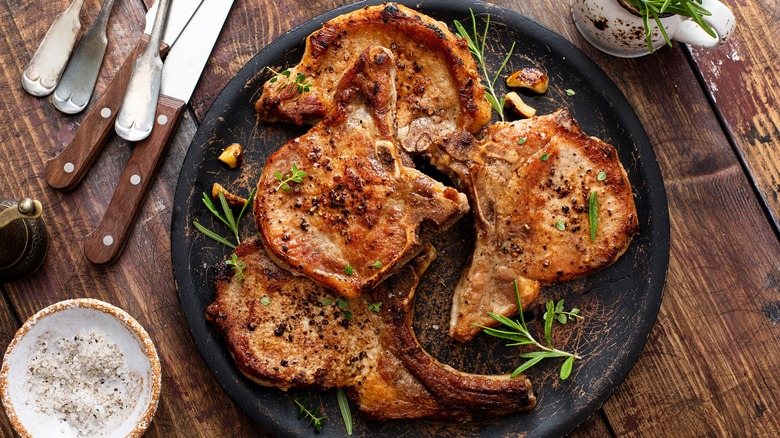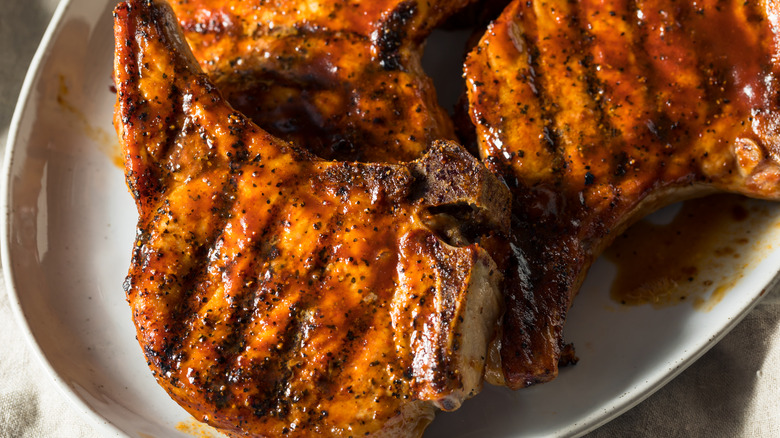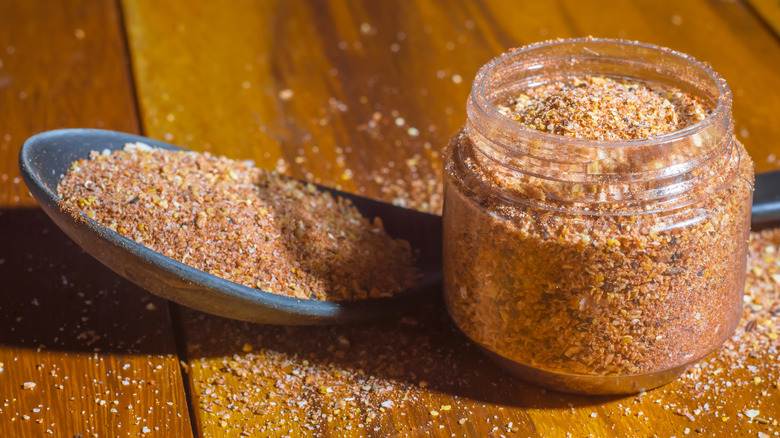Dry Brine Your Pork Chop For The Crust Of Your Dreams
Imagine you're given the choice between a pork chop that's tender, juicy, and enveloped in a gorgeous brown crust, versus one that's quicker to make, but far less flavorful. We can all probably agree on which result we prefer, which is why dry brining — an easy extra prep step — is a must-try for perfect pork chops. It may be convenient to take your chops right from the fridge and into the pan, but a little extra time and effort can be the difference between a ho-hum meal and a spectacular one.
No matter what kind of meat you're cooking, a good crust equals more complexity and flavor. A dry brine not only allows your pork chops to develop a deep brown crust from caramelization and the condensation of carbonyl and amines – compounds that encourage browning — but it also tenderizes the meat and makes it more juicy and flavorful, resulting in some superiorly scrumptious pig. The cherry on top? Dry brining won't make a mess of your kitchen before you start cooking, like wet brining can. A wet brine involves soaking the meat in a vat of salted water that you're likely transferring in and out of the fridge, so for a neater process, you can skip the traditional brine in favor of something better.
Why the dry brine gives you a superior crispy crust
To create an exceptional crust on a pork chop, you need to expose it to very high heat, making sure there's as little moisture on the exterior as possible. If you use a dry brine that contains sugar, you also bring enhanced caramelization into the equation. A dry brine enhances the meat's crust while also giving you the flavor and tenderizing benefits of wet brining, without adding too much moisture to the surface.
How does it work? A dry brine mixture is made with salt, sugar, and optional seasonings. Because of how the sodium and chloride ions in salt interact with water molecules inside meat, the dry brine extracts water from the muscle through osmosis. That moisture dissolves the salt and sugar in the brine, creating a very concentrated, salty liquid on the surface of the meat. The meat eventually reabsorbs this liquid, which tenderizes and flavors it from the outside in. It's the same science behind a wet brine, but without the mess or excess water absorption, which can end up diminishing the flavor of your meat.
Once they're done brining, pat your pork chops dry — like, super dry — and cook in a hot pan or grill. The Maillard reaction, the chemical process that browns foods, and caramelization of residual sugars on the meat will help it quickly develop an impressive crust, without the risk of dryness, leaving you with a tender, flavorful result.
The dry brine options are endless
Arguably the best thing about the dry brine method is just how flexible and adaptable it is. To get the tender, flavorful, beautifully browned meat we're looking to achieve, salt and sugar are non-negotiable ingredients in your dry brine mixture. But beyond those two basic components, there is endless room for customization of flavor.
Add paprika, garlic, and mesquite seasoning to the dry brine, throw your dried chops on a hot grill, and finish them off with your favorite sauce for an incredible barbecue pork recipe everyone will love. Use gochugaru (chili paste) and ground, toasted sesame seeds for a spicy, Korean-inspired pork chop. Or pair dried herbs like rosemary, thyme, and sage with black pepper and crushed fennel seed for a chop that will elevate any Mediterranean meal. No matter what cooking method or inspirational cuisine is calling you, mix salt and sugar with whichever seasonings your heart desires and get in the kitchen — dry brining has great things to offer you.



